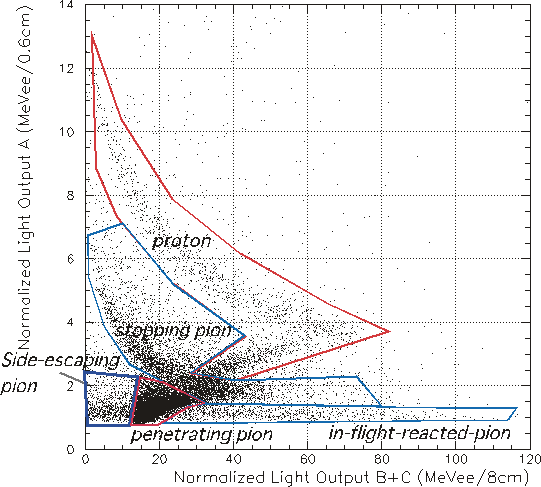Today's Progress 3. Oct. 2006 (updated every moment)
p/&pi separation on TC-VDC arm
Methods
Obtainning the expected peak position of dE/dx on TC A/B/C/D layers by
Monte-Carlo simulation for stopped K^+, we fix constant "gain factor" firstly.
Since we have the "observed momentum distribution" from the stopped K^- reaction, hence run-by-run (or term-by-term) gain tune is feasible with "stopped K^-" run. Here, our purpose is to achieve a good p/&pi separation. To do that, Various TC-defined quantities, as
1. Light Output of A/B/C/D layers which is defined by the sum of the values from all TDCwise fired segments on each arm,
2. Meantime on A/B/C/D layers which is defined by the value of the segment with the largest light output,
3. Time difference on A/B/C/D layers which is defined by the value of the segment with the largest light output,
4. TDC multiplicy of A/B/C/D layers,
can be investigated, in relation to VDC-detected particle track.
Data Analysis 1 - Corrlelation of Detected Energies on A/B/C layers
A vs B+C energy correlation at run 130-135 (K^-)
A vs B+C detected energy correlation.
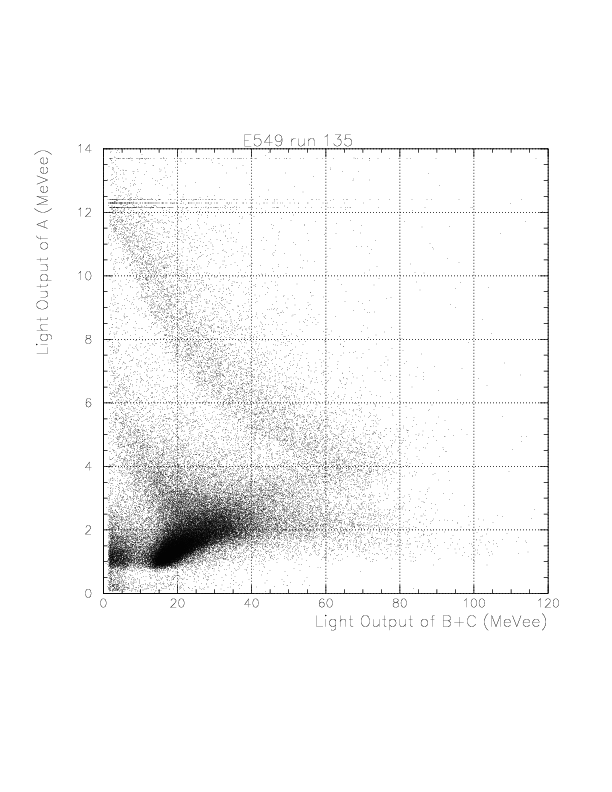
A vs B+C when the detected energy on A is normalized by chamber direction cos.

A vs B+C when B+C is normalized by chamber direction cos.
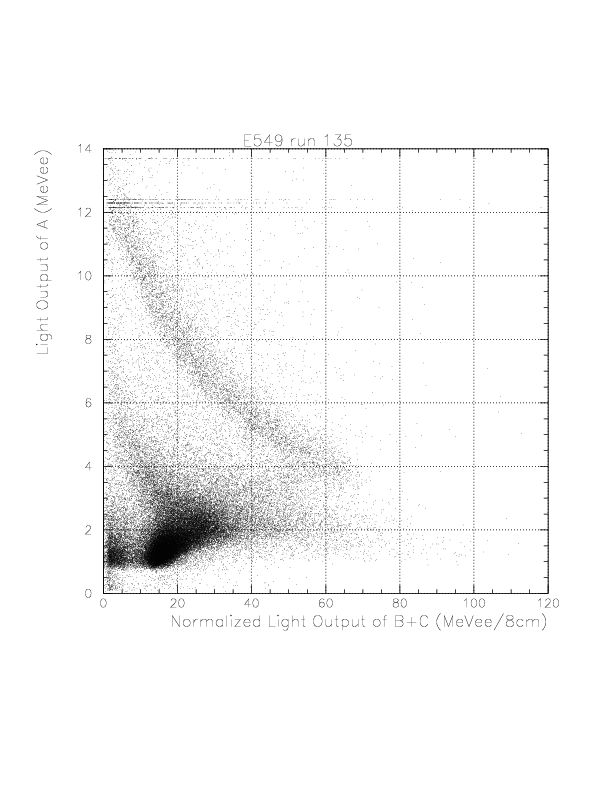
A vs B+C when both of A and B+C are normalized.

A vs B+C normalized energy if C has no TDC hit. Cstop or Cpass component is unseen, then.
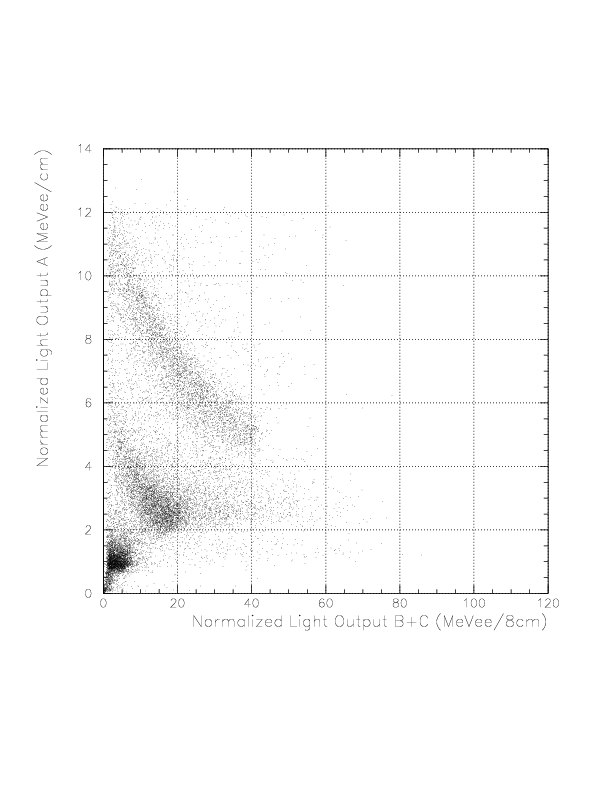
A vs B+C normalized energy if C has a TDC hit. Bstop component is unseen, then.
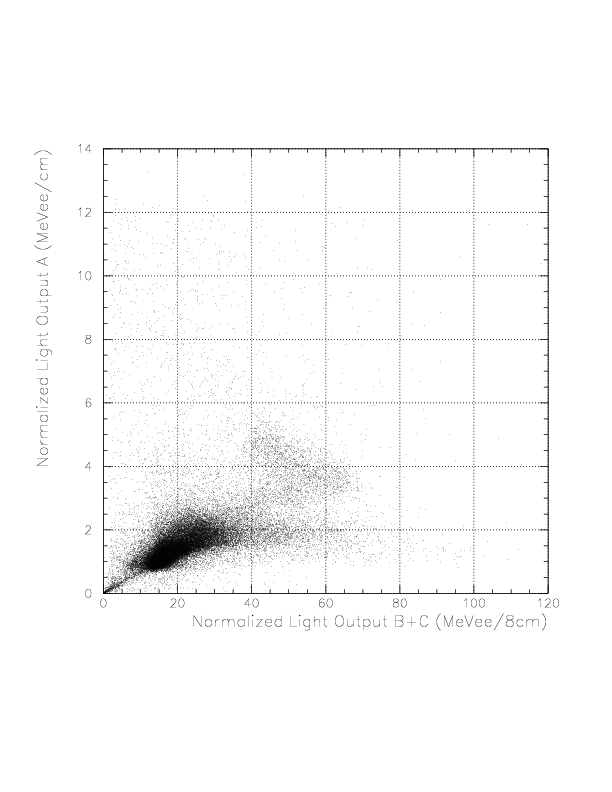
A vs B+C normalized energy if D has a TDC hit. Only Cpass component is seen, then.
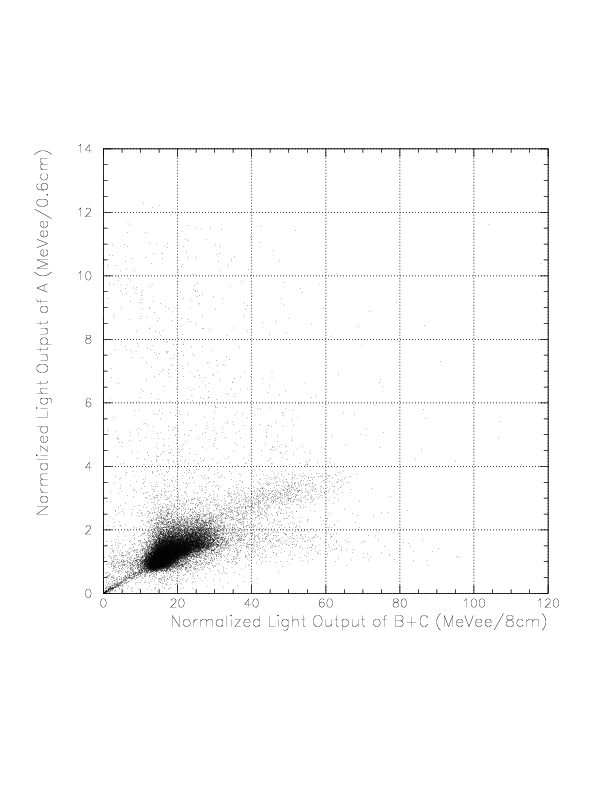
A vs B+C normalized energy if D has no TDC hit. B/Cstop component is seen, then.
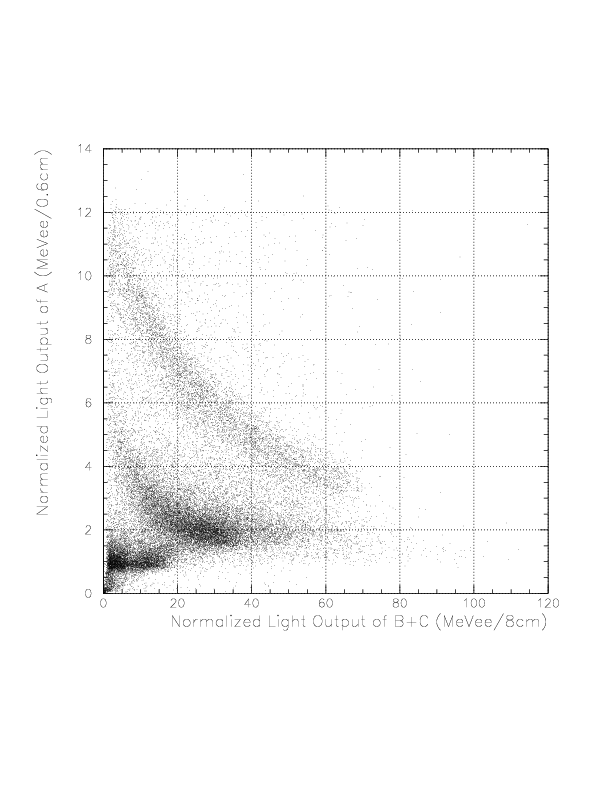
A vs B energy correlation at run 130-135 (K^-)
A vs B detected energy correlation.
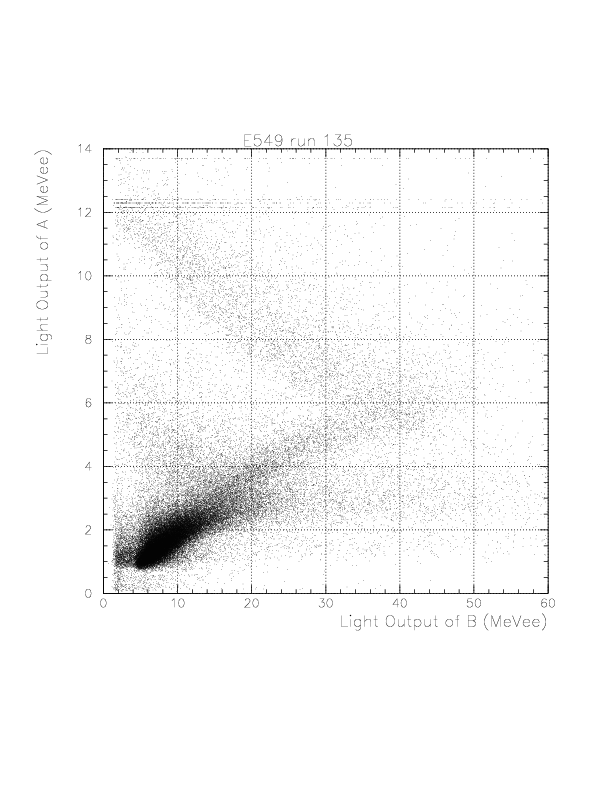
A vs B when the detected energy on A is normalized by chamber direction cos.
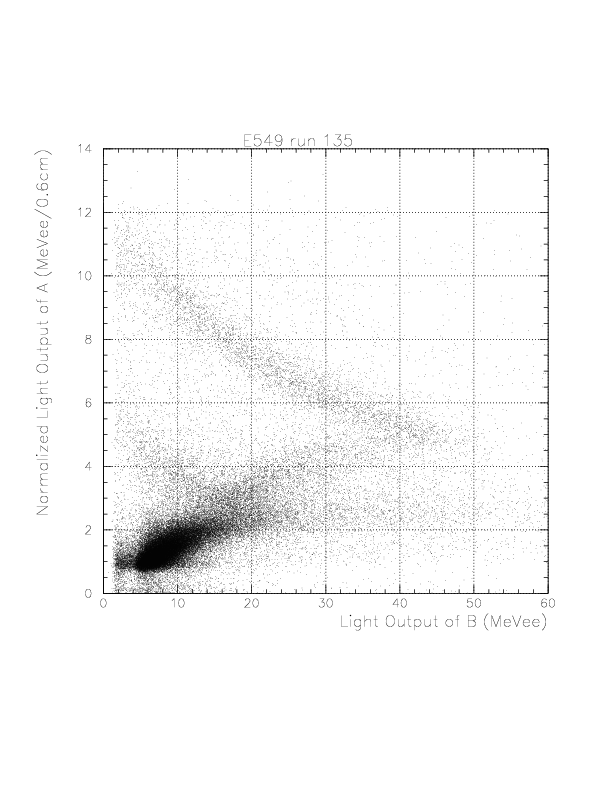
A vs B when B is normalized by chamber direction cos.
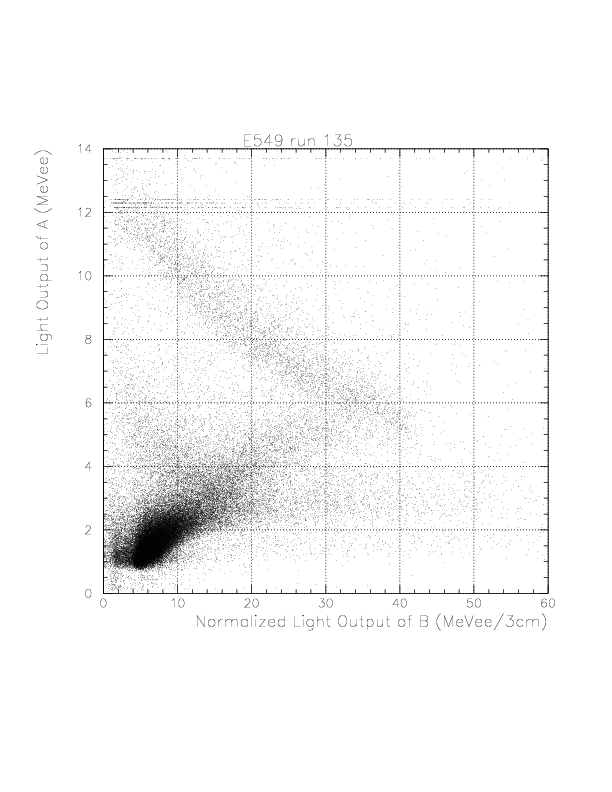
A vs B when both of A and B are normalized.
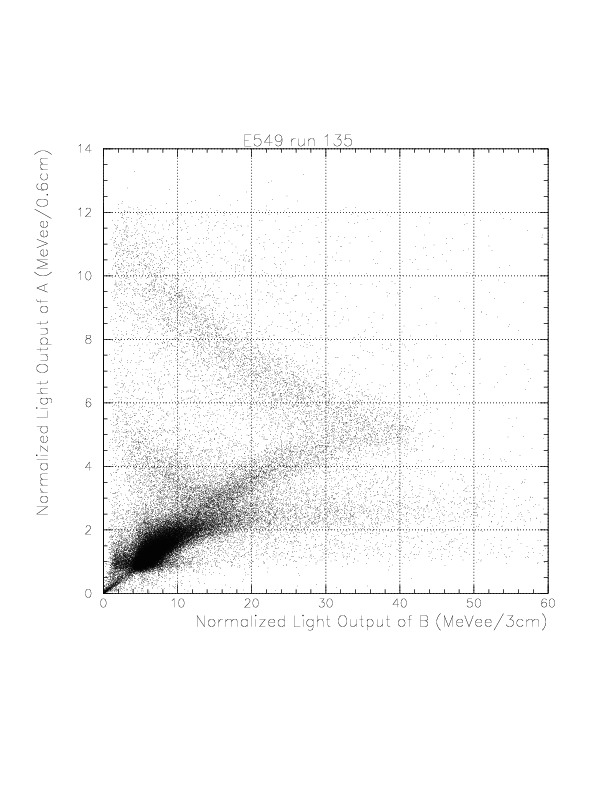
A vs B normalized energy if C has no TDC hit. Only Bstop component is seen, then.

A vs B normalized energy if C has a TDC hit. Only Bpass component is seen, then.

A vs B normalized energy if D has a TDC hit. Only Bpass component is seen, then.
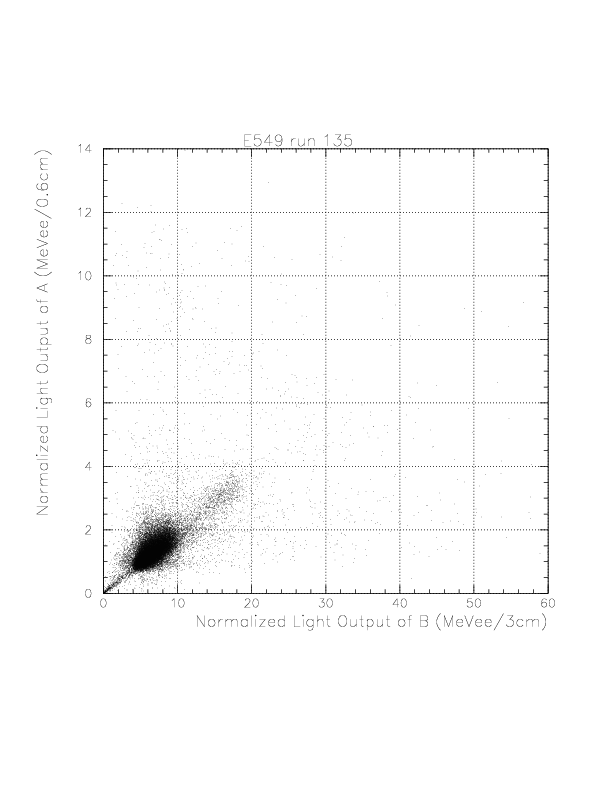
A vs B normalized energy if D has no TDC hit. Bstop component is seen, then.
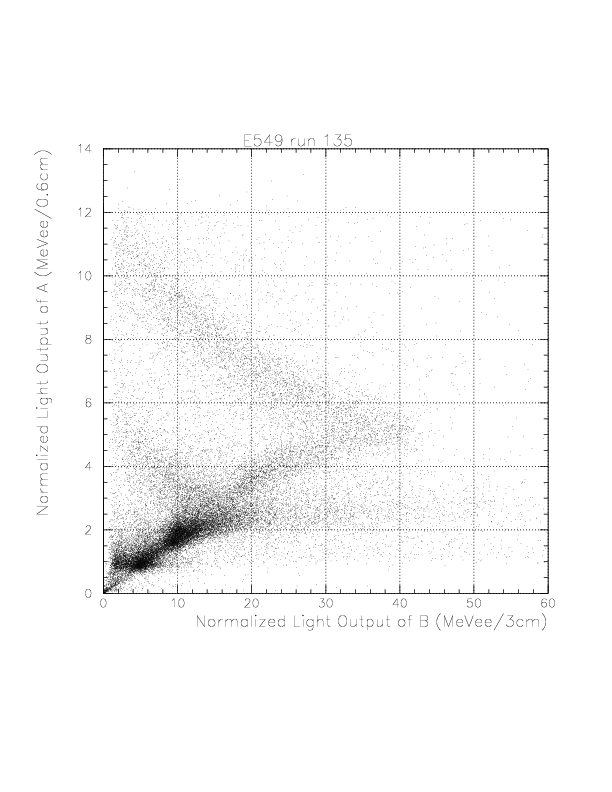
TOF vs Energy correlatrion on A layer at run 130-135
In order to purify the event selection and make all existing hit pattern available, TOF between
T0 and TC_A layer is available. Note that
TC slewing correction is done PMT by PMT with conventional method with COSMIC RAY DATA,
TC relative offsets are determined with COSMIC RAY DATA,
T0 slewing correction and offsets are adopted from those obtained from T0-PA-PB analysis.
Kaon flight time is calculated from the z position, and eliminated.
T0-TC_A TOF vs Light output on A.

T0-TC_A TOF vs Normalized Light output on A.
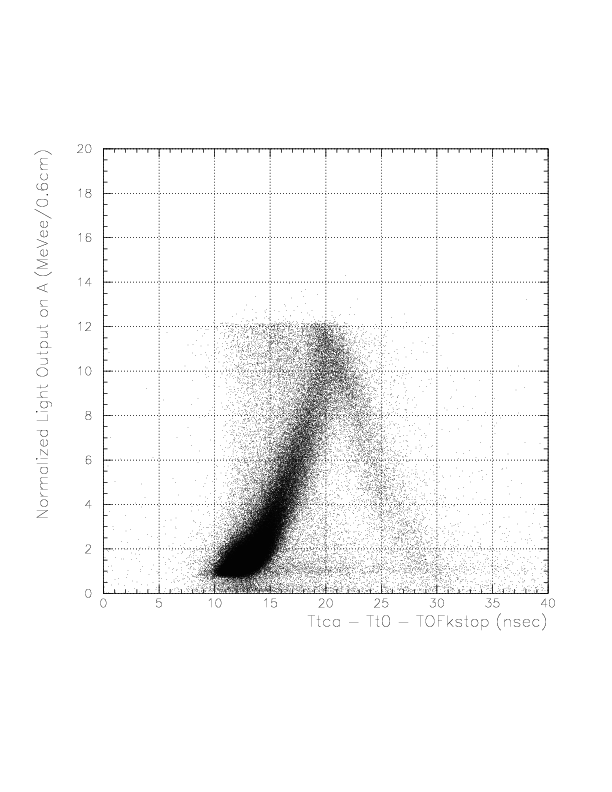
T0-TC_A TOF vs Normalized Light output on A when B has a hit.
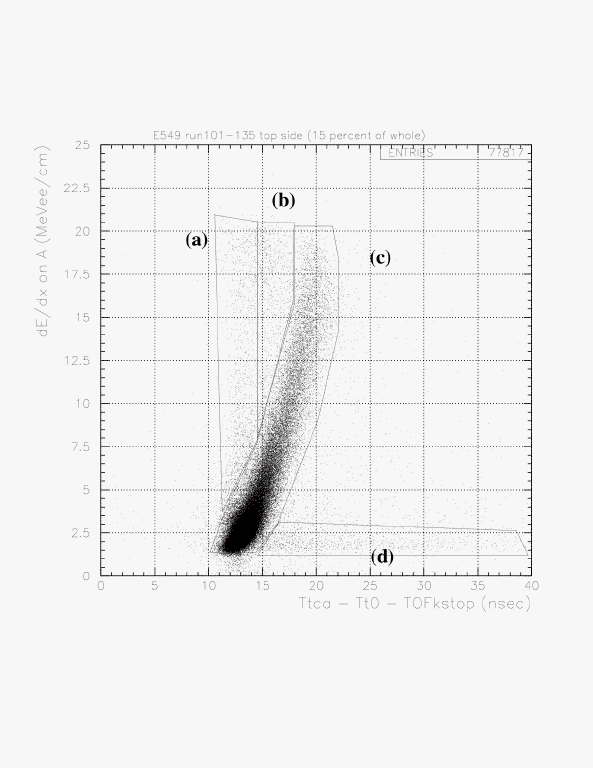
T0-TC_A TOF vs Normalized Light output on A when B has no hit. 13 % of Kstop*VTC*NT events having no TCB hit.
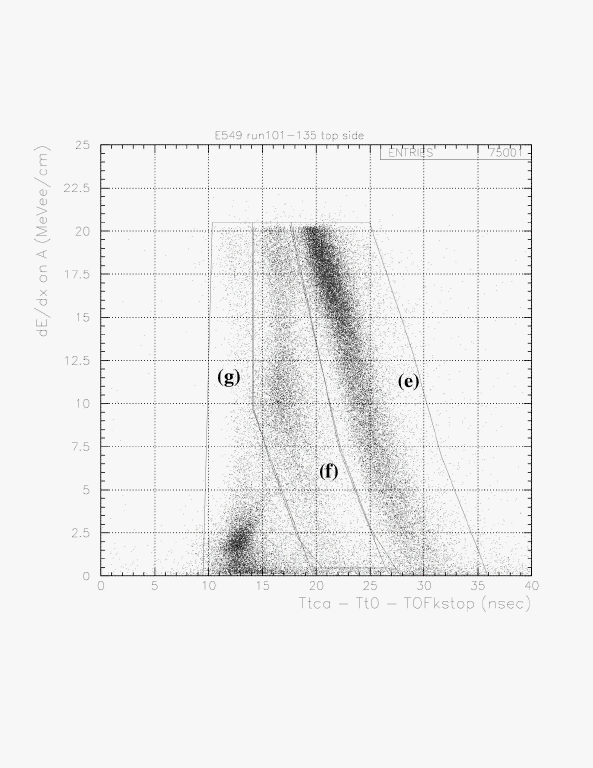
It is understood that we have 3+3 components, which are separated by TOFvsEnergy on A, and Blayer hit. If we have at least one Blayer hit, the events are separated as
When B-layer having a hit - 87% of all
Relatively fast pion reacted inside A layer. The reaction product fired B. They should be categolized as 'pion', but should be eliminated from 'slow/fast pion' - (a)
stop pion on A. The reaction product fired B layer. They should be categolized as 'slow pion' - (b)
penetration without any hadron reaction, to which A vs B+C energy analysis is available. Further selection will be applied - (c)
delayed events from meta-stable orbit capture. Accidental neutron dominates, then. Or, TOF analysis does not work even if the events are Kaon-nuclear reaction after undergoing the meta-stable orbit. They should be eliminated from the final spectrum - (d)
When B-layer having no hit - 13% of all
stop proton on A. They should be categolized as 'proton' - (e)
stop pion on A. The reaction product did not fire B layer. They should be categolized as 'slow pion' - (f)
Relatively fast pion reacted inside A layer. The reaction product did not fire B. They should be categolized as 'pion', but should be eliminated from 'slow/fast pion' - (g)
Below, A vs B+C normalized energy correlations are shown for components (a), (b), (c), and (d).
Correlation betwen Normalized Light Output A and B+C for event set (a).
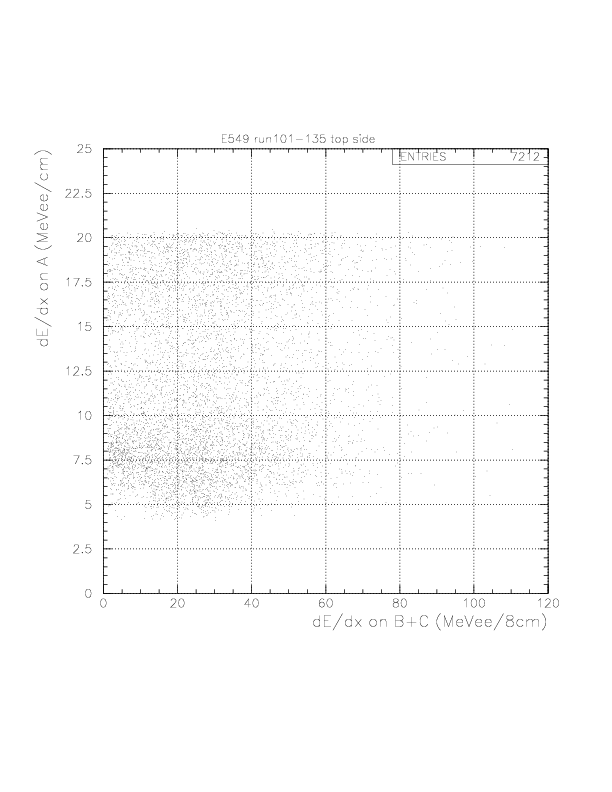
Correlation betwen Normalized Light Output A and B+C for event set (b).

Correlation betwen Normalized Light Output A and B+C for event set (c).
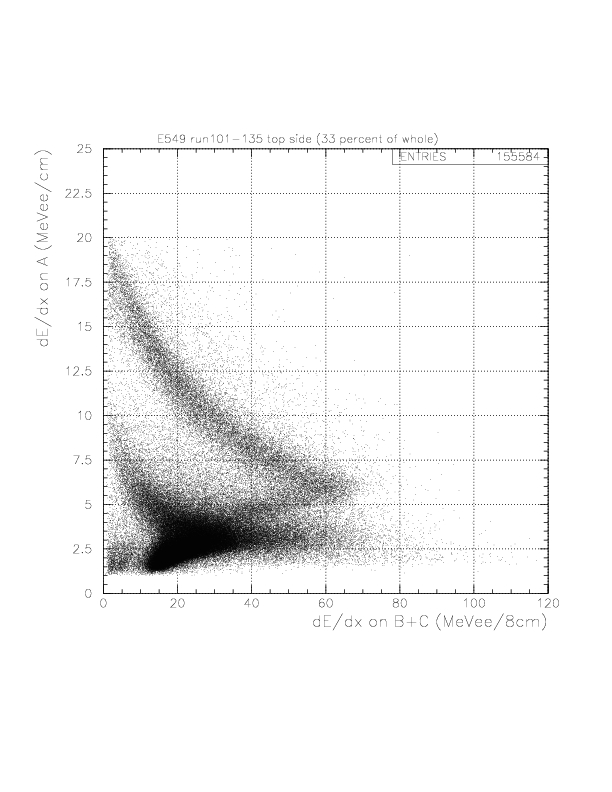
Correlation betwen Normalized Light Output A and B+C for event set (d).

For the component (c), further classification can be applied with B/C/D information as follows:
D layer is fired. This corresponds to the case that the particle penetrated the B and C, and its incident energy is relatively large. -> dE/dx on A vs dE/dx on B+C is the most effective to separate p/pi(selection (&alpha), (&beta), respectively).
D layer is NOT fired. This corresponds to the case that the particle stopped inside B or C, and its incident energy is relatively small. -> dE/dx on A vs dE on B+C is most effective to separate p/pi (selection (&gamma), (&delta), respectively).
Correlation betwen dE/dx on A and B+C if D layer having a hit.
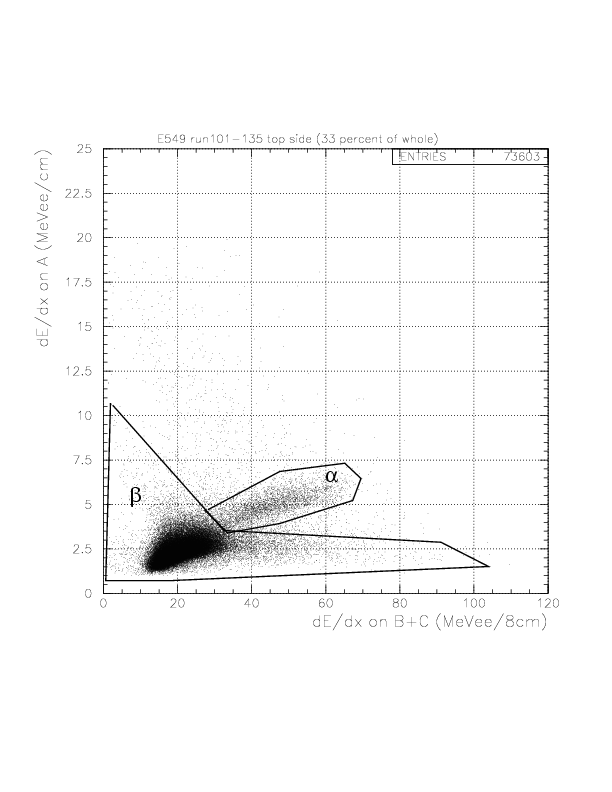
Correlation betwen dE/dx on A and dE on B+C if D layer has no hit.
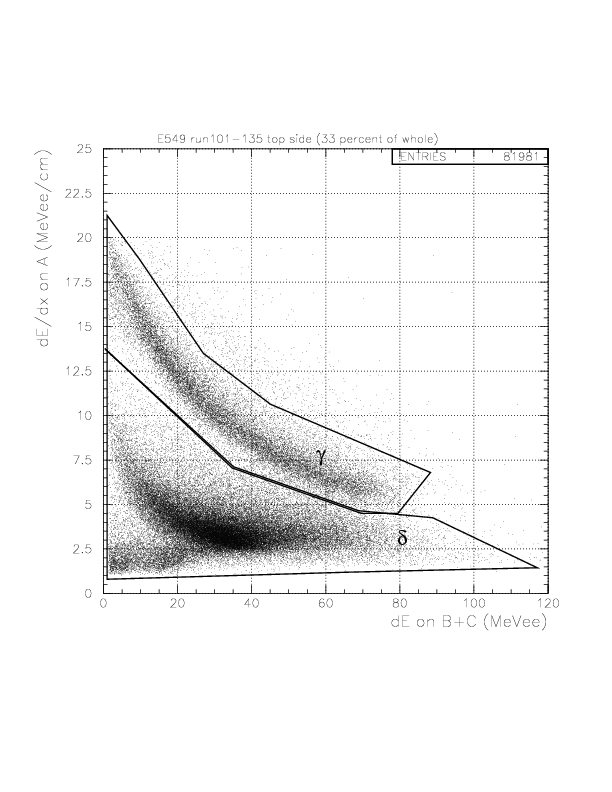
Definition of p/&pi selection and pion momentum
According to the discussion developed in the previous section, Definition of p/&pi selection is as below.
"p" = (c.AND.(&alpha .OR. &gamma)) .OR. e ,
"&pi" = a .OR. b .OR. (c.AND.(&beta .OR. &delta)) .OR. f .OR. g ,
Note that (a)~(g) having no overlapping each other, and (&alpha)~(&delta) also.
Correlation betwen dE/dx on A and dE/dx on B+C for "p"(c.AND.(&alpha .OR. &gamma)).

Correlation betwen dE/dx on A and dE/dx on B+C for "&pi"(c.AND.(&beta .OR. &delta)).
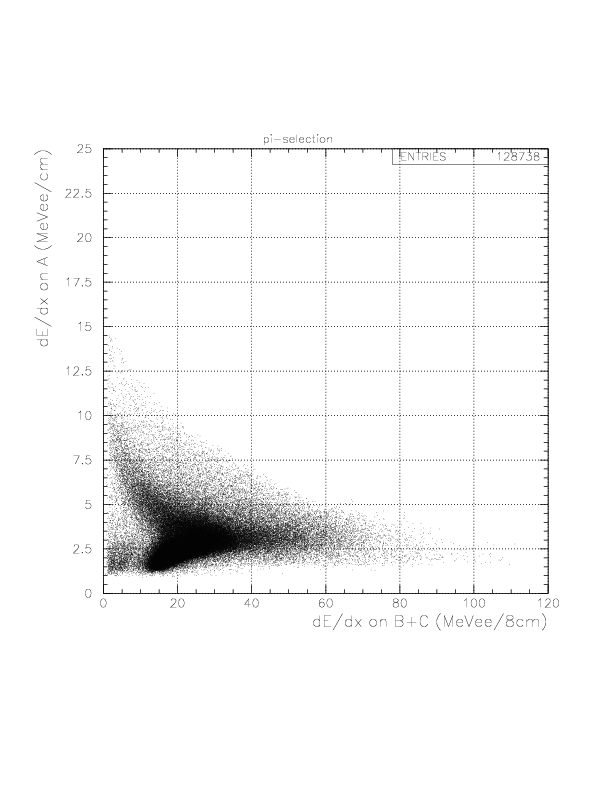
Correlation betwen dE/dx on A and dE/dx on B for "p"(c.AND.(&alpha .OR. &gamma)).
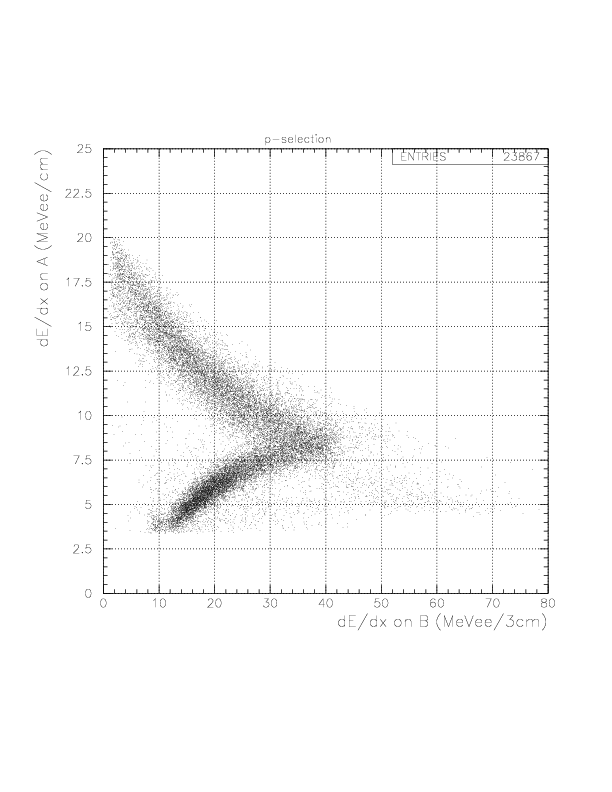
Correlation betwen dE/dx on A and dE/dx on B for "&pi"(c.AND.(&beta .OR. &delta)).
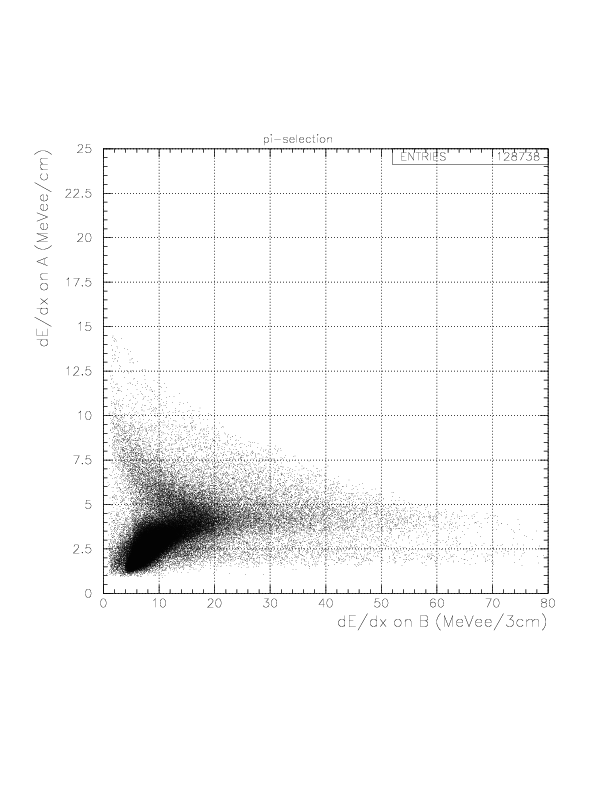
Monte-Carlo simulation
In order to study the event selection, a Monte-Carlo simulation has been performed. The conditions on the simulation are as follows.
1. Realistic set-up, and the distribution of the source points.
2. VDC planes are reproduced by representative 2 layers(layer 1 and 12 among all), and VDC hit is explicitly imposed to get the resulting physical quantities. VDC-detected direction cos is defined by the accurate value at the entrance to the second plane.
3. p/pi^+/pi^- are produced by 1:2:7 with uniform momentum distribution (0~300 MeV/c for pion, 0~700 MeV/c for proton) for 4-pi direction.
4. Hadron reaction is activated. Hence, stopped pi^- is absorbed by the nucleus, while a stopped pi^+ decays at rest. In-flight reaction of p/pi^+/pi^- are activated.
A front view of the virtual setup

Results if secondary charged particle tracking is NOT activated.
Simulated correlation with no event selection.
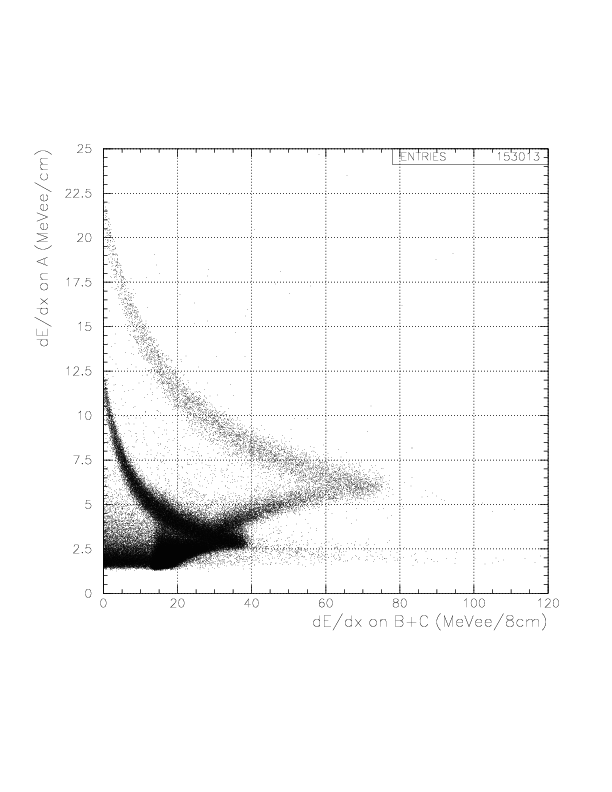
In order to study the nature of each component, several event selections are applied.
Simulated correlation if reaction occurred in-flight on B or C.

Simulated correlation if no in-flight reaction occurred on B and C.
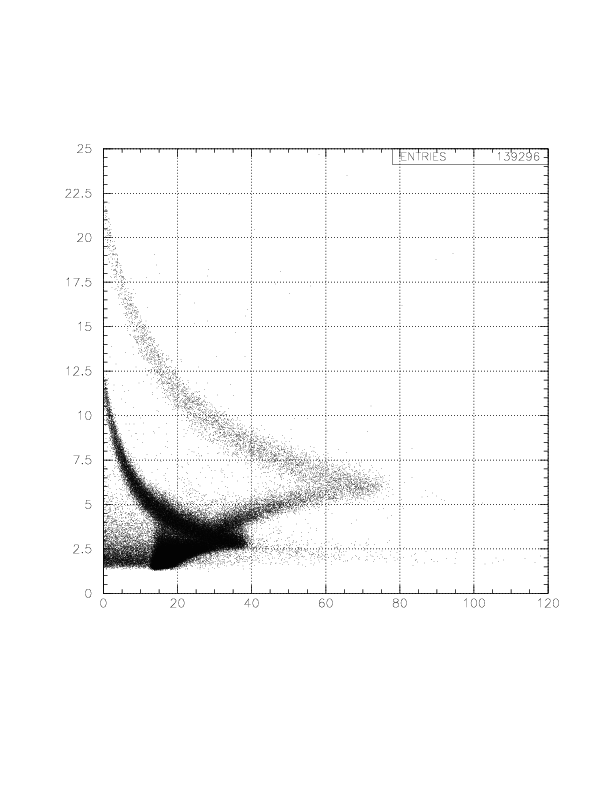
Simulated correlation if no in-flight reaction occurred on B and C, and if hit position on A layer is limitted at 60cm >|x|,|z|.
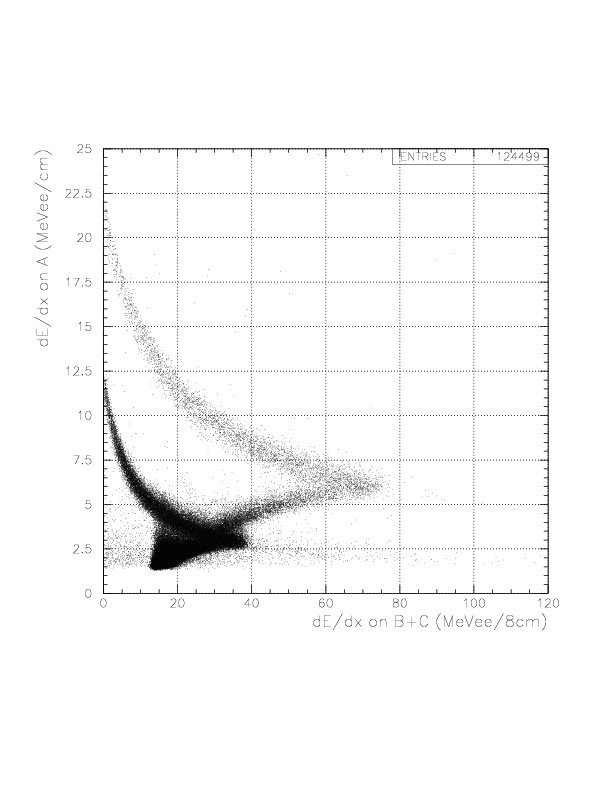
Simulated correlation if D-layer is fired.
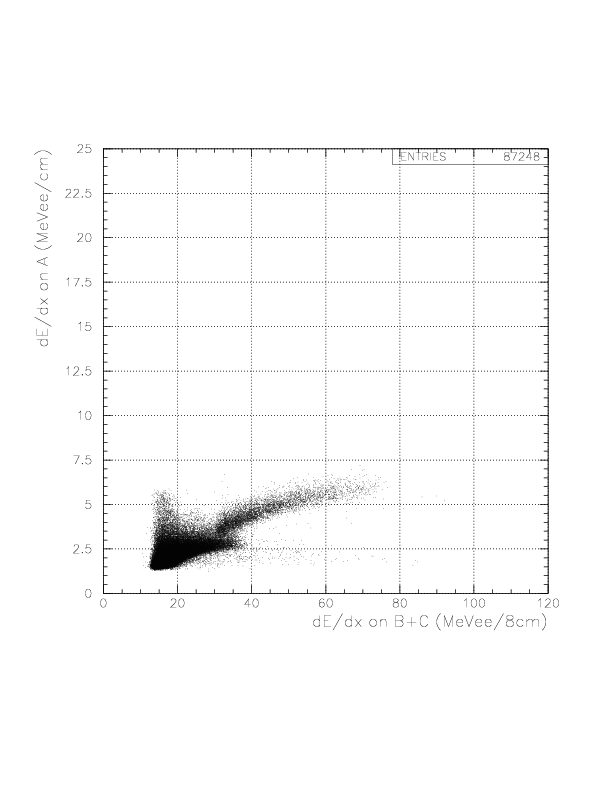
Results if secondary particle tracking is activated.
Simulated correlation with no event selection.
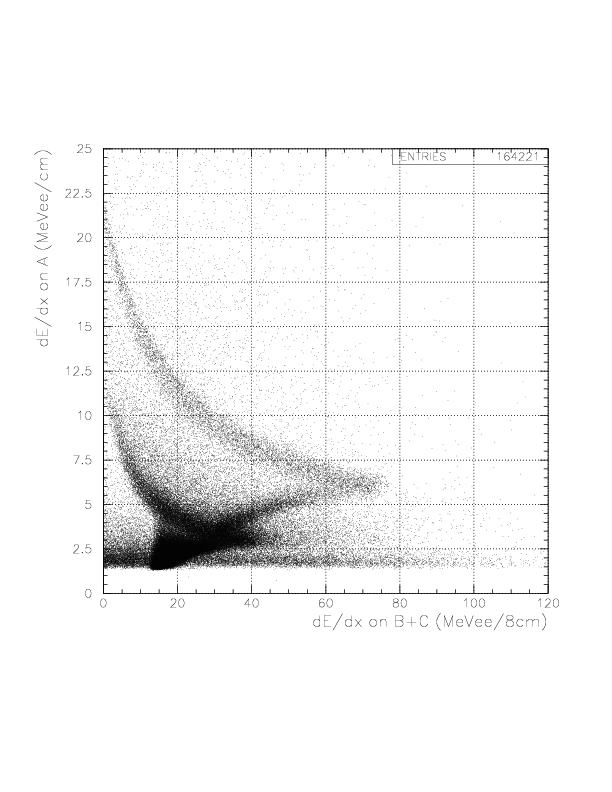
Simulated correlation if reaction occurred in-flight on B or C.
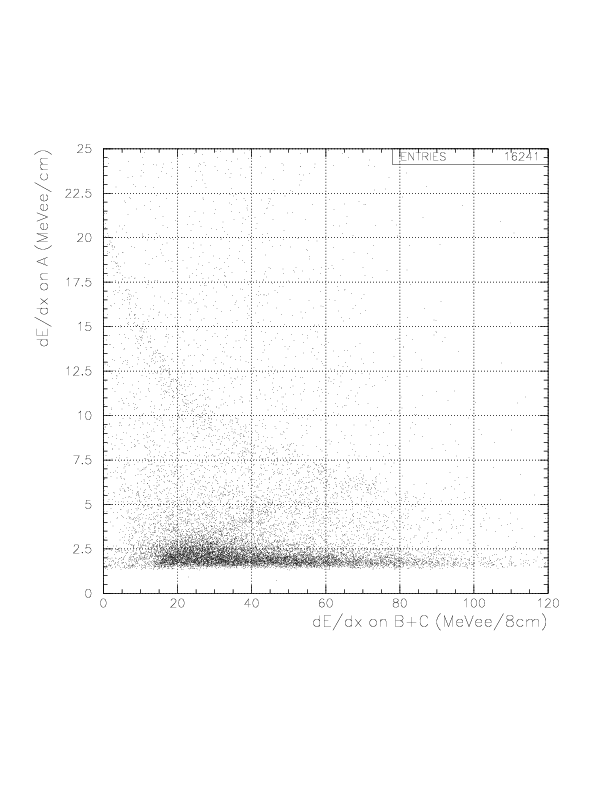
Simulated correlation if no in-flight reaction occurred on B and C.
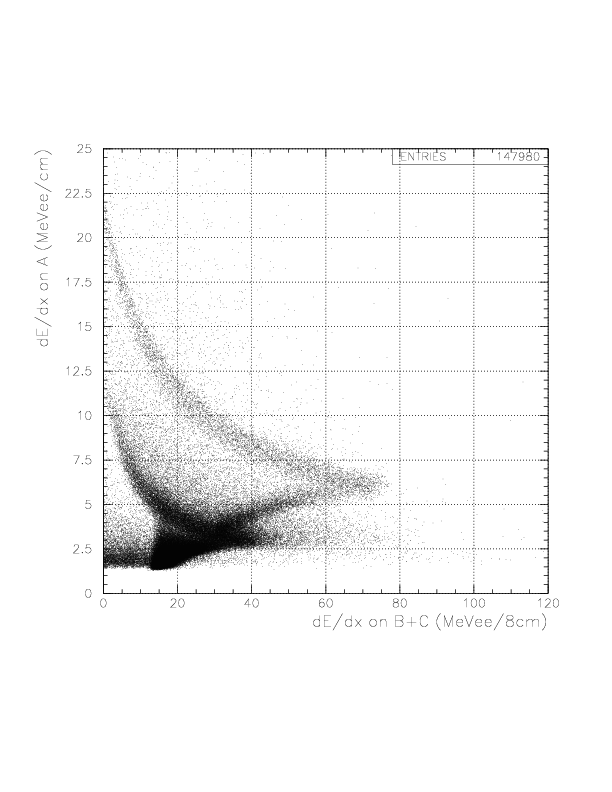
Simulated correlation if no in-flight reaction occurred on B and C, and if hit position on A layer is limitted at 60cm >|x|,|z|.
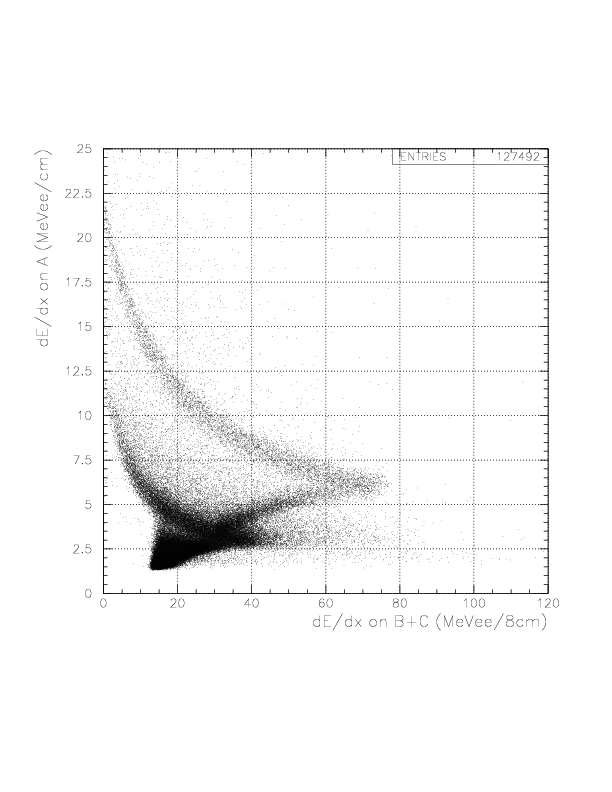
Simulated correlation if D-layer is fired.

&pi^-(top)/&pi^+(bottom) momentum distribution if D is fired. Pion momentum threshold value is found to be ~127 MeV/c (defined at half maximum), then. When pion incident momentum is beyond 140 MeV/c, the pion reaches the D layer regardless of the incident angle.
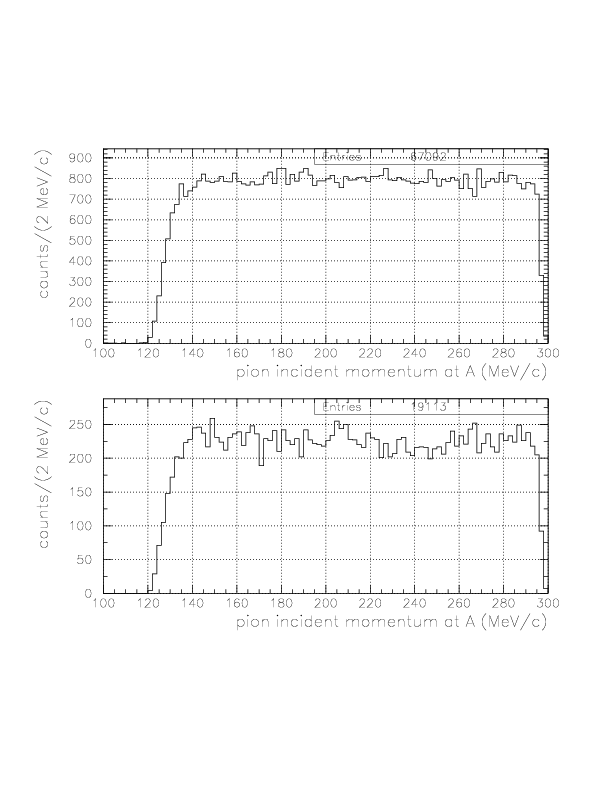
&pi^-(top)/&pi^+(bottom) momentum distribution if C is fired. Pion momentum threshold value is found to be ~95 MeV/c (defined at half maximum), then.

Classification of the events
Now, all components on the dE/dx-dE/dx correlation has been well understood as below.
